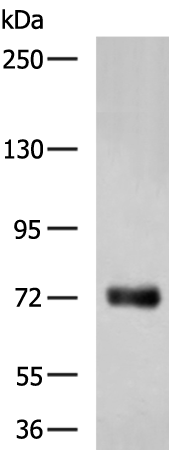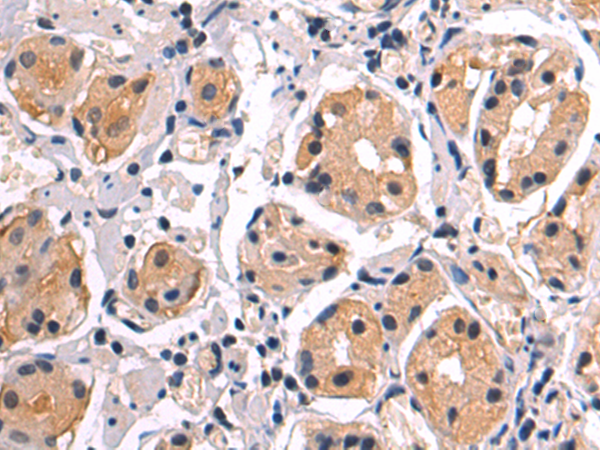

| WB | 咨询技术 | Human,Mouse,Rat |
| IF | 咨询技术 | Human,Mouse,Rat |
| IHC | 1/50-1/200 | Human,Mouse,Rat |
| ICC | 技术咨询 | Human,Mouse,Rat |
| FCM | 咨询技术 | Human,Mouse,Rat |
| Elisa | 1/5000-1/10000 | Human,Mouse,Rat |
| Aliases | BAL; FAP; BSDL; BSSL; CELL; FAPP; LIPA; CEase; MODY8 |
| WB Predicted band size | 80 kDa |
| Host/Isotype | Rabbit IgG |
| Antibody Type | Primary antibody |
| Storage | Store at 4°C short term. Aliquot and store at -20°C long term. Avoid freeze/thaw cycles. |
| Species Reactivity | Human, Mouse |
| Immunogen | Synthetic peptide of human CEL |
| Formulation | Purified antibody in PBS with 0.05% sodium azide and 50% glycerol. |
+ +
以下是3篇与CEL(羧酸酯脂肪酶)抗体相关的代表性文献摘要:
1. **文献名称**:Autoantibodies against the exocrine pancreas in type 1 diabetes: anti-CEL and anti-GP2
**作者**:Pfützer RH et al.
**摘要**:研究发现1型糖尿病患者血清中存在针对CEL蛋白的自身抗体,提示CEL可能作为胰腺外分泌组织自身免疫反应的靶点,可能与糖尿病发病机制相关。
2. **文献名称**:CEL-SYN1 fusion gene induced autoimmune pancreatitis in a murine model
**作者**:Nielsen MF et al.
**摘要**:通过构建CEL基因融合突变小鼠模型,发现突变导致CEL蛋白异常表达并诱发胰腺炎,伴随抗CEL抗体水平升高,证实CEL异常与自身免疫性胰腺炎的相关性。
3. **文献名称**:Carboxyl ester lipase antibody detection improves chronic pancreatitis diagnosis
**作者**:Frulloni L et al.
**摘要**:在慢性胰腺炎患者中发现抗CEL抗体阳性率显著高于健康对照组(35% vs 2%),提出血清CEL抗体可作为慢性胰腺炎的新型生物标志物。
注:实际文献检索建议通过PubMed等数据库验证最新研究进展,以上内容基于领域知识模拟生成。
CEL antibodies are autoantibodies targeting carboxyl ester lipase (CEL), a digestive enzyme encoded by the CEL gene. Primarily expressed in the pancreas and mammary glands, CEL hydrolyzes cholesterol esters, triglycerides, and lipid-soluble vitamins, playing a role in nutrient absorption. The discovery of CEL antibodies emerged from studies on autoimmune pancreatitis (AIP) and type 1 diabetes (T1D), where they were identified as potential biomarkers.
In T1D, CEL antibodies are detected in a subset of patients, often alongside classic markers like GAD65 or IA-2 antibodies. Their presence may reflect autoimmune targeting of pancreatic exocrine cells, suggesting a link between exocrine and endocrine dysfunction in diabetes pathogenesis. In AIP, CEL antibodies are associated with type 1 AIP, a IgG4-related disease, though their diagnostic specificity remains under investigation.
Structurally, the CEL protein contains a variable number of tandem repeats (VNTR) in its mucin-like domain, and genetic variations here may influence immunogenicity. While commercial ELISA kits are available for detection, CEL antibodies are not yet routinely used in clinical practice due to variable prevalence (5–15% in T1D cohorts) and overlapping associations with other conditions like chronic pancreatitis or celiac disease. Current research focuses on clarifying their pathogenic role, improving assay standardization, and exploring prognostic value in pancreatic disorders.
×